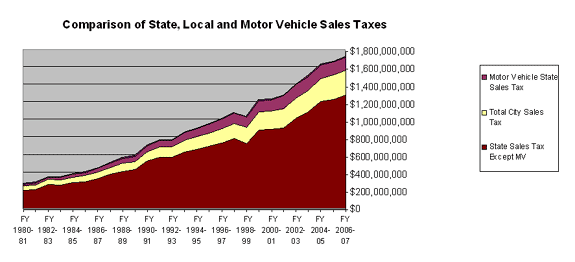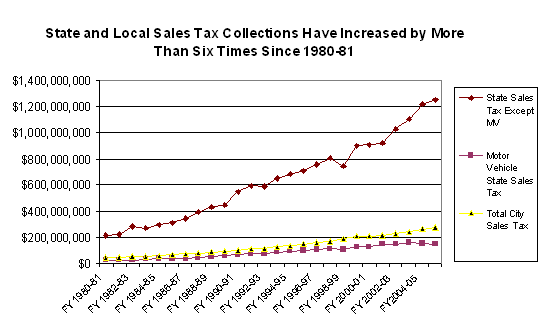
Taxes in Nebraska > Sources of Major State and Local Taxes > Sales Taxes
SALES TAXES
|
Overview The
sales and use tax is generally considered a tax
on consumption.
It is usually added to the purchase price of
any retail sale, collected by the seller and returned
to
the
state.
The state collects the state and all municipal
sales taxes except the tax on motor vehicles. Forty-six states and the District of Columbia
have a sales tax, although a handful, most notably
New
Mexico and Hawaii, levy the tax as a gross receipts
tax on businesses generally. While
tax experts would argue that the tax is to be levied
only on final consumption, Nebraska, like most states
imposes the tax on at least some business purchases. Prominent
among the business purchases subject to sales tax
are business machinery and supplies. Most
exemptions are also for business purchases, notably
ingredient and component parts, sales for resale, packaging
containers, manufacturing machinery and most interstate
transportation equipment. The
use tax is a tax levied on persons that purchase goods
or services in another state for use in Nebraska. Any sales tax paid in another state satisfies
the use tax responsibility, so the use tax comes into
play only when an individual or business makes a taxable
purchase in another state where the retailer does not
collect any tax from the purchaser. This is either because the purchase is tax exempt
in the other state or the sale is made remotely with
a company that has no obligation to collect Nebraska
tax. The legal
restrictions that prevent collection of the sales tax
are described in detail in the "Sales Tax History and
Program Description" page. This can be accessed by clicking the text box
that appears below.
This page also contains a more detailed history
and description of the Nebraska sales and use tax. Generally,
the sales tax base in Nebraska is any retail sale of
tangible personal property, unless exempted, and selected,
listed, retail sales of services.
Therefore, sales of a newly-invented good would
automatically be included in the sales tax base while
sales of a newly invented service would not.
Sales of real estate are not in the base. Prior
to the enactment of LB 1085 (2002) and LB 759 (2003),
Nebraska's sales tax base included 48 services according
to a survey done periodically by the Federation of Tax
Administrators. This was about average nationally but was more
narrow than most of the states bordering on Nebraska. The recent expansion of the base increased
the number of services taxed in Nebraska to 76 based
on the 2004 FTA survey. This is still fewer than Iowa
and South Dakota, but is more than other states in
the region. Under this measure, Nebraska ranks 10th
nationally. Ranking information appears on a ranking
page that may be accessed below. Adequacy - Sales tax tends to be reliable, at least when compared to income tax. People and businesses both tend to consume taxable goods and services even when the economy is weak. Over the last 20 years, the sales tax has grown 93% as fast as personal income. The fact that Nebraska historically has expanded the base to include services infrequently has limited its growth potential. This shortcoming may be changing with recent actions. Nevertheless a growth rate near the rate of growth in the economy is better than excise taxes or the corporate income tax. Equity - The sales tax is universally viewed
as a regressive tax. While
the exemption of food may make it less regressive, the
tax still hits low-income people harder than high-income
people. The Citizens
for Tax Justice organization has issued reports detailing
the degree of regressivity
of different features in some detail, and these reports
are available. From
the standpoint of horizontal equity, the tax also presents
problems. Exemptions,
particularly those based on the item or service creates
differences between similar taxpayers.
Sales tax burden is not determined by the services
utilized, economic position, ability to pay, or even
the overall level of consumption. Instead, the level of tax depends on what is
consumed, that is goods versus services, or food versus
automobiles. The local option sales tax also means that where
it is consumed makes a difference in how much tax is
paid. However,
despite its negatives from the standpoint of equity,
the sales tax remains popular with the public.
Many people view it as the most "fair" and policy
makers in most states have used it in fill recent shortfalls
in revenues. There
is some connection between the benefits received from
government and consumption of goods and services in
the state economy. This
helps mitigate the negatives of the tax from the standpoint
of equity. Simplicity - For taxpayers, the tax is relatively simple because he or she pays a little bit at a time. This also helps make the tax popular among taxpayers. The sales and use tax also is relatively easy to administer from the standpoint of the state since retailers collect most of it. Audits of retailers are generally combined with other tax programs so the costs are reduced. The local option sales tax, by law, taxes exactly the same base of transactions as the state sales tax at a uniform rate. This simplifies collection of the local tax, at least as compared to some other states that allow local government to determine the base within their jurisdiction. Recent efforts with other states to make sales and use taxes more uniform in definitions, exemption administration, registration to collect tax, and other administrative details are designed to make the tax even more simple to comply with for multistate retailers. There are difficulties in administration, however, the existence of exemptions means that disputes arise over the taxability of particular purchases, especially business purchases. Quite often, disputes occur where a business argues that purchase of an item critical to a manufacturing process results in that item becoming a "component part" of the final product and, therefore, exempt, while the Department of Revenue argues that the item is "consumed" in the process and is therefore not exempt. The biggest enforcement problem for states, however, is probably collection of the use tax on remote sales. The commerce clause of the U.S. Constitution, as reaffirmed in Quill Corp. v. North Dakota, limits Nebraska's ability to address this problem except by interstate compact or congressional action. The Streamlined Sales and Use Tax Agreement, which Nebraska has signed and become a party to, is to resolve many of these difficulties with more uniform procedures and definitions. The idea is to reduce the burden that multistate sellers face in complying with dozens of different sales tax systems. The hope is that Congress or the Supreme Court will allow the collection of sales tax by out of state retailers if the Streamlined Sales and Use Tax system is in place. The Streamlined Sales and Use Tax Agreement became operative Oct. 1, 2005, with Nebraska among the 18 member states that are fully compliant with its provisions. The
tax is difficult to administer from the standpoint of
the retailer. Exemptions
to the tax are a complicating factor, especially since
some exemptions are based on what the product is, for
example food, while others are based on the status of
the purchaser, for example schools or hospitals. Other exemptions depend on the use of the product
by the purchaser, for example, purchases for resale, or purchases
of machinery to be used in agriculture. Accountability - The fact that the tax is collected a little
at a time separates the taxpayers' act of paying the
tax from the provision of services.
The tax is less accountable to taxpayers than
the property tax or even income tax. Economic competitiveness - In theory, a sales tax should tax only consumption
within the state and would not tax consumption outside
the state. If
this were so, the tax would be economically neutral. In
practice it is more complicated. Consumers do cross
state lines to buy goods and services, and sales tax
rates and exemptions can influence these decisions. Another
negative factor is the extent to which retailers locate
outside city limits to avoid collecting city sales taxes. As
applied to consumers, which is about 60 percent
of sales
tax collections, the tax is fairly neutral. All the states surrounding Nebraska have a sales
tax, and Nebraska's rate is about average. As applied to the 40 percent of the sales tax
that is collected from business as consumers, the
tax
can affect economic decision-making. Many
states, including Nebraska,
do not collect a sales tax on purchases of manufacturing
machinery. The taxation of business inputs has been a concern
in many states, including Nebraska, and it is generally
considered unwise to expand the base to include out-of-state
consumption. Some years ago Florida attempted to broaden
its sales tax base greatly by apportioning to Florida
goods
and services, particularly advertising, which were
purchased in a national marketplace. The legislation was quickly repealed without
ever having been effective. |

[
Click on a type of tax in the box in the
chart above to view related information. ]
|
The sales tax has three components that are measured separately in this presentation. Most state sales tax is collected by the Department of Revenue and deposited in the state's General Fund. However, the state sales tax collected on sales and short-term leases of motor vehicles is collected by counties when the motor vehicle is registered and is deposited in the Highway Trust Fund. The Highway Trust Fund is divided 53 1/3 percent to the state and 46 2/3 percent is divided equally between cities and counties. Any sales tax collected on sales and short-term leases of motor vehicles that is in excess of 5% (currently 0.5%) is deposited in the Highway Allocation Fund which is divided equally between cities and counties. Under Nebraska law, all proceeds from either fund must be spent on construction or maintenance of state highways, city streets, or county roads. The distribution formula for road and street funds is described in the narrative link to this presentation that deals with the motor vehicle fuel tax. City sales tax is collected by the state and returned to the municipalities levying the tax for deposit in the city's general fund. Municipal sales tax on sales of motor vehicles is also collected by counties at registration, but is deposited in the city's general fund. LB 904, enacted in 2006 requires cities and counties to expend all proceeds from local sales taxes collected from sales of motor vehicles for road and street purposes unless such proceeds were pledged for a preexisting bond issue. The reader may examine the growth of all three components of the sales tax by clicking on these items in the legend box to the right of the area chart above. All have grown faster than the growth in the economy over the 25-year study period. The comparison is to Nebraska personal income as a measure of the state's economy, and the Consumer Price Index for all Urban Consumers as a measure of inflation. Both are provided by the U.S. Bureau of the Census and are subject to revision from time to time. |
|
1. State sales taxes have increased at more than the rate of growth in the economy since 1980, a rate of growth more than twice the rate of inflation. This rate of growth has been achieved despite the fact that the natural growth in the sales tax base is less than the growth rate of the economy and there was little legislation expanding the base during this period. The growth evident in the above line chart has been fuelled primarily by increases in the rate of tax. The state sales tax rate was 3% in 1980 and is 5.5 percent today. In looking at the line chart in relation to the chronology below, LB 59 (1983) was a temporary, half-cent increase and LB 539 (1986) was a permanent one half-cent increase that was effective Jan. 1, 1987, so the effects were spread over two fiscal years. The full one cent increase in LB 1059 (1990) and the one-half cent decrease from LB 1104 (1998) are more obvious from the chart. The recent increase in the rate of sales tax to 5.5% [LBs 1085 (2003) and 759 (2003)] are plainly visible in this chart. 2.
City sales
taxes also increased more than two and one-half times
the rate of inflation
and more than the rate of growth in the economy. Growth
in city sales taxes has been due to far more cities
levying the tax and rate increases for some
cities
previously levying a municipal sales tax. Since 1995,
the number of cities and villages with a local option
sales tax has doubled to more than 130. Property taxes
used by municipalities, on the other hand have grown
much more slowly. The rate of growth for these taxes
has been less than inflation since 1980. Total tax
spending by cities and villages has grown faster
than
inflation but less than the growth rate of the Nebraska
economy. The net effect of these trends on city
finances is a dramatic shift in reliance from property
taxes
to sales taxes over the past 25 years. Today, sales
tax is the leading tax source for municipalities contributing
37% of total tax funds. Property taxes contribute 35%. For
more detail, please review "Cities
Increasing Use of Local Option Sales Taxes". 3.
State sales taxes
on motor vehicles grew even faster before declining
the last three years. The rapid growth
through FY2003-04 is hard to explain, but it may
be a combination of
state rate increases and increases in the prices of
new and used automobiles. |
||||||||||||||||||||
Additional Information:
|
|
|
